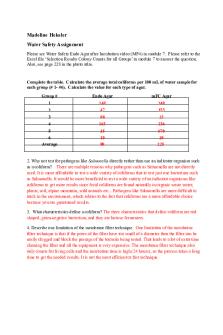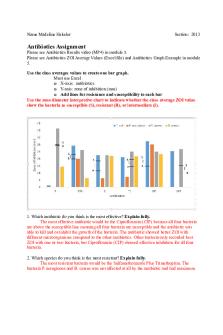bio 245 Lab 8 worksheet PDF

| Title | bio 245 Lab 8 worksheet |
|---|---|
| Author | Maddy Hekeler |
| Course | General Microbiology (2, 4) |
| Institution | James Madison University |
| Pages | 3 |
| File Size | 94.7 KB |
| File Type | |
| Total Downloads | 43 |
| Total Views | 156 |
Summary
Dr. Powers comprehensive notes...
Description
Madeline Hekeler Water Safety Assignment Please see Water Safety Endo Agar after Incubation video (MP4) in module 7. Please refer to the Excel file ‘Selection Results Colony Counts for all Groups’ in module 7 to answer the question. Also, see page 228 in the photo atlas.
Complete the table. Calculate the average total coliforms per 100 mL of water sample for each group (# 1- #6). Calculate the value for each type of agar. Group #
Endo Agar
mFC Agar
1
148
240
2
47
153
3 4
88 163
23 236
5
25
670
6 Average
10 80
29 225
2. Why not test for pathogens like Salmonella directly rather than use an indicator organism such as a coliform? There are multiple reasons why pathogens such as Salmonella are not directly used. It is more affordable to test a wide variety of coliforms that to test just one bacterium such as Salmonella. It would be more beneficial to test a wide variety of an indicator organisms like coliforms to get more results since fecal coliforms are found naturally in organic waste water, plants, soil, alpine mountain, wild animals etc... Pathogens like Salmonella are more difficult to track in the environment, which relates to the fact that coliforms are a more affordable choice because you are guaranteed results. 3. What characteristics define a coliform? The three characteristics that define coliform are rod shaped, gram-negative bacterium, and they are lactose fermenters. 4. Describe one limitation of the membrane filter technique. One limitation of the membrane filter technique is that if the pores of the filter have too small of a diameter then the filter can be easily clogged and block the passage of the bacteria being tested. That leads to a lot of extra time cleaning the filter and all the equipment is very expensive. The membrane filter technique also only counts for living cells and the incubation time is high (24 hours), so the process takes a long time to get the needed results. It is not the most efficient or fast technique.
5. Why is Endo agar or mFC agar used for this test instead of Trypticase soy agar (TSA)? Endo agar and mFC agar are the same in the fact that they only select for gram-negative bacteria, so it allows us to see the results more quickly. TSA plates can select for both gram-negative and grampositive bacteria; and we don’t want gram-positive bacteria growing on our plates since we are only searching for coliforms. We use two different medias, Endo agar and mFC agar, just to see how the media plates would select differently on each type, since they select for gram negative bacteria by inhibiting gram positive bacteria. The coliforms that grow on an endo agar appear green and the coliforms that grow on the mFC agar appear blue. 6. Consider the composition of m-Endo agar and mFC agar. How would adding glucose to these media affect the results? Explain fully. Adding glucose to the media results of m-Endo agar and mFC agar would affect the results by disrupting the fermentation process and inhibiting the growth of gram-negative coliforms. The two medias that are used isolate coliform bacteria by providing nutrients such as lactose and peptone to help them grow. Coliforms are gram negative bacteria and grow well on these medias by fermenting the lactose present in the medias. When glucose is added, glucose would become the primary source of their growth instead of lactose. The coliforms will use up all of the glucose, and the lactose will remain in the media hindering the growth expected from the coliforms. 7. Suppose you were to count one coliform colony produced from a 10 mL water sample. What is the coliform density of the water in cells per 100 mL? Is the water potable? Y/N? Explain fully. The coliform density of the water would be 10 coliforms per 100mL. No, the water is not potable. In order for the water sample to be potable, safety guidelines have established a rule of less than 1 coliform per 100mL. Only then can the water be considered safe to drink. 10 coliforms per 100mL is obviously higher and therefore not safe to drink. 1x100/10mL = 10 coliforms per 100mL 8. Suppose you were to count ten coliform colonies produced from a 100 mL water sample. What is the coliform density of the water in cells per 100 mL? Is the water potable? Y/N? Explain fully. The coliform density of this sample would still be 10 coliforms per 100mL. Therefore, this water sample is not potable. This again goes against the safety guidelines that are established which state that water is only safe to drink when there is less than 1 coliform per 100mL. 10x100/100mL = 10 coliforms per 100 mL...
Similar Free PDFs

bio 245 Lab 8 worksheet
- 3 Pages

bio 245 Lab 11 worksheet
- 2 Pages

Lab 8 Worksheet
- 4 Pages

Lab 8 Muscle worksheet
- 4 Pages

bio181L 08 worksheet lab 8
- 5 Pages

Bio 7 lab 8 review ques
- 1 Pages

Lab #8 - Lab 8
- 3 Pages

Bio-Worksheet-Mutations
- 2 Pages

Chapter 10 worksheet - bio
- 8 Pages

Ap Bio Photosynthesis Worksheet
- 2 Pages

Bio lab 1 - Stomata lab
- 3 Pages
Popular Institutions
- Tinajero National High School - Annex
- Politeknik Caltex Riau
- Yokohama City University
- SGT University
- University of Al-Qadisiyah
- Divine Word College of Vigan
- Techniek College Rotterdam
- Universidade de Santiago
- Universiti Teknologi MARA Cawangan Johor Kampus Pasir Gudang
- Poltekkes Kemenkes Yogyakarta
- Baguio City National High School
- Colegio san marcos
- preparatoria uno
- Centro de Bachillerato Tecnológico Industrial y de Servicios No. 107
- Dalian Maritime University
- Quang Trung Secondary School
- Colegio Tecnológico en Informática
- Corporación Regional de Educación Superior
- Grupo CEDVA
- Dar Al Uloom University
- Centro de Estudios Preuniversitarios de la Universidad Nacional de Ingeniería
- 上智大学
- Aakash International School, Nuna Majara
- San Felipe Neri Catholic School
- Kang Chiao International School - New Taipei City
- Misamis Occidental National High School
- Institución Educativa Escuela Normal Juan Ladrilleros
- Kolehiyo ng Pantukan
- Batanes State College
- Instituto Continental
- Sekolah Menengah Kejuruan Kesehatan Kaltara (Tarakan)
- Colegio de La Inmaculada Concepcion - Cebu




